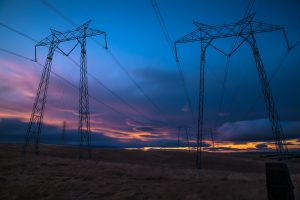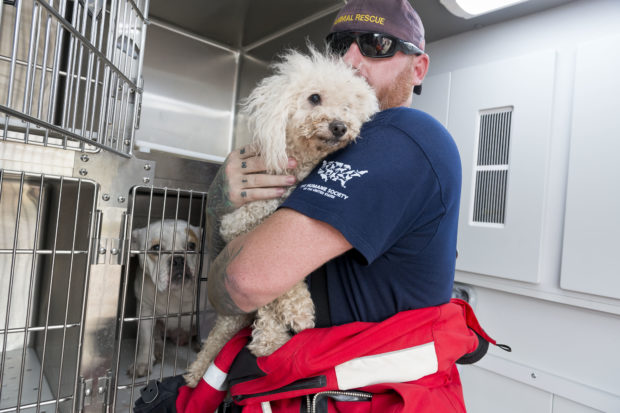Illinois Becomes Ninth State to Enact Automatic Voter Registration
Monday, August 28, 2017
Read moreDedicated To People, The Planet, and All Its Inhabitants – Since 1996

Monday, August 28, 2017
Read moreFriday, August 25, 2017
Read more
Cleveland Amory was a trailblazing advocate for animals from the 1950s until his death in 1998. His wit and gift for the spoken word were his sharpest weapons. Photo by The HSUS
It’s hard to believe that Cleveland Amory, who was without question one of the most important and influential animal advocates of the 20th century, would be 100 today. When it came to animal protection, he was a man of resolve and action. With the whipping winds and pelting rains of Harvey approaching the Texas land . . .
The post A tribute to the great Cleveland Amory on his centenary birthday appeared first on A Humane Nation.

Late Wednesday night, the U.S. Department of Energy (DOE) released its so-called “study” on grid reliability.
Secretary Perry commissioned the report in this April memo, asking the DOE to investigate whether our electric grid’s reliability is threatened by the “erosion of critical baseload resources,” meaning coal and nuclear power plants. Perry took the unusual step of providing his own, pre-study conclusion, claiming that “baseload power is necessary to a well-functioning electric grid.”
His own report disagrees. It’s largely a backward-looking report that sometimes argues with itself, but comes, albeit grudgingly, to the same conclusion as every other recent study: the electric grid continues to operate reliably as uneconomic coal diminishes. Moreover, coal is declining because it can’t compete, and other resources are ensuring reliability at more affordable rates.
Perry seems undeterred by the evidence however, and the report’s accompanying cover letter and recommendations appear ready to double down on his pro-coal agenda. Here are three ways he tries to twist the facts in favor of dirty coal – a move that ignores more efficient, affordable, and innovative solutions and comes at a cost to Americans.
The misdirection spin
Perry’s letter accompanying the report included this nugget:
“It is apparent that in today’s competitive markets certain regulations and subsidies are having a large impact on the functioning of markets, and thereby challenging our power generation mix.”
Although Secretary Perry continues to blame “regulations and subsidies” for “challenging” the power generation mix (despite the mix becoming more, not less, diverse as more renewables come online), he would be well advised to read his own report if he’s looking for the real driver of coal retirements. The report he commissioned clearly states:
“The biggest contributor to coal and nuclear plant retirements has been the advantaged economics of natural gas-fired generation.”
Secretary Perry continues to ignore the evidence on grid reliability, even his own
Click To Tweet
This is hardly new information; extensive study has found that “decreases in natural gas prices have had a much larger impact on the profitability of conventional generators than the growth of renewable energy.” Coal is simply too costly to compete. And low natural gas prices, in addition to flat demand for electricity, are making energy more affordable.
The reliability spin
On reliability, again Perry’s letter takes one stance:
“The industry has experienced massive change in recent years, and government has failed to keep pace.”
And the report states the opposite:
Grid operators “are working hard to integrate growing levels of [renewable energy] through extensive study, deliberative planning, and careful operations and adjustments.”
Although Perry appears unaware of the thorough performance his own study references, grid operators are required by law to ensure reliable electricity at affordable rates. And indeed, government has kept pace. As the DOE report noted, the North American Electric Reliability Corporation’s most recent annual State of Reliability analysis concluded that the electric grid was reliable in 2016. And 2015. And 2014. And 2013. And although the DOE report neglected to mention it, this same State of Reliability analysis found that reliability has been increasing.
Certainly, more can and should be done. As the DOE report mentions, increasing the use of fast, flexible resources support a healthy grid. Unfortunately for Perry, coal can’t provide what’s needed, as the DOE report notes,
“For a power plant to make money today, it must be able to ramp up and down to coincide with the variable levels of renewable generation coming online. That makes combined cycle natural gas plants profitable…but coal plants have relatively high and fixed operating costs and are relatively inflexible.”
Coal, simply put, is too slow and old to respond nimbly.
The resiliency spin
Perry also attempts to pivot from focusing on reliability to resiliency, a lesser defined term:
“Customers should know that a resilient electric grid does come with a price.”
Like everything worth having, resiliency comes at a price, but that price should be cost-effective. But coal is part of the problem, not the solution to achieving affordable, resilient, and reliable electricity. Not only do coal-fired power plants unexpectedly break down more than any other resource, they have performed poorly during extreme weather events, as his report notes:
During extreme weather events in 2014 “many coal plants could not operate due to conveyor belts and coal piles freezing.”
During extreme weather events in 2014 “many coal plants could not operate due to conveyor belts and coal piles freezing.”
“Forced outages,” meaning the instance when a power station is unavailable to produce power due to an unexpected breakdown, are higher for coal than any other resource – almost twice as high, in fact, as the next highest resource. Coal also needs twice as much scheduled maintenance, referred to as “planned outages,” as any other resource.
A terrible solution in search of a problem
When Secretary Perry originally requested the DOE report, he already knew the grid reliability answer he was looking for. Unfortunately for him, the final report – despite best efforts – only further illustrates why his pre-study pro-coal conclusion is wrong. The report’s recommendations and his letter double down on coal despite the evidence, no matter the cost to the American public; no matter the cost to human health and the environment; and no matter the cost to the well-being of the electric grid itself.
Now that the report is finally here, coal companies likely will continue complaining and seeking help for their uneconomic power plants. Meanwhile, America’s grid will continue to embrace new, innovative technology that builds a cleaner, reliable, affordable, and resilient energy system.

Our teams on the ground are assisting with assessments of damage and need, and with rescue efforts. Photo by Anthony Rathbun/AP Images for The HSUS
The broadcast images are telling. A hovering Coast Guard helicopter lifts a family from a rooftop, 150 feet into the air, and then safely out of danger. The family includes a husband and wife couple in their late 50s or 60s and their two Boston Terriers, who seem to take the harrowing lift in stride. . . .
The post HSUS disaster response expanding with rescues and transports appeared first on A Humane Nation.
State of Risk: Nevada, a new report from the Environmental Defense Fund (EDF), catalogues far-reaching and grave threats to air,[…]
Read moreAs the first trilateral meeting of the governments of China, Mexico and the United States on illegal totoaba trade comes to an end today, WWF urges swift action to halt the trafficking of totoaba swim bladders and save the vaquita. The world’s mo…
Read more This week, the oil and gas giant Shell took a positive step toward addressing methane emissions. The company announced a new technology trial at a wellsite in Alberta, Canada, where it is piloting a specially designed laser to continuously monitor emissions of methane, a powerful pollutant known to leak from oil and gas equipment.
This week, the oil and gas giant Shell took a positive step toward addressing methane emissions. The company announced a new technology trial at a wellsite in Alberta, Canada, where it is piloting a specially designed laser to continuously monitor emissions of methane, a powerful pollutant known to leak from oil and gas equipment.
The move by Shell is a glimpse into the future and demonstrates growing market interest in smart, sensor-based methane detection technology. Shell’s project joins a similar field test already underway in Texas, operated by the Norwegian producer Statoil, and a California utility pilot run by Pacific Gas and Electric Company.
Each of these deployments is promising, but the ultimate test will be broad-scale adoption of innovations that generate actual methane reductions.
For industry, there is an incentive to move ahead. An estimated $30 billion of natural gas (which is largely methane) is wasted every year due to leaks and flaring from oil and gas operations worldwide. In addition, roughly 25 percent of global warming is driven by methane. Oil and gas methane emissions also contain chemicals that adversely affect public health.
For these reasons, methane is a problem that has caught the attention of regulators, investors and consumers alike. Advancing new technologies to enable the oil and gas industry to tackle this challenge more efficiently is key, even as companies use established tools to manage emissions now.
Collaborations Spark Methane Innovation
When you bring the right people to the table, innovative solutions will follow. Behind the Shell, Statoil and PG&E demonstration projects is a collaborative initiative, the Methane Detectors Challenge, begun by the Environmental Defense Fund four years ago. The project united eight oil and gas companies, R&D experts, and technology innovators in an effort to accelerate the development of next-generation methane detectors.
The formation of this project was motivated by a key insight: new technology to manage emissions needs to be created and deployed faster than ever. The Methane Detectors Challenge offers a unique resource to innovators – access to real facilities and collaboration with potential customers – which is essential to help entrepreneurs understand the market, demonstrate demand, and ultimately achieve economies of scale.
Both the Statoil and Shell pilots are using a solar-powered laser, created by Colorado-based Quanta3. The technology uses the Internet to provide real-time data analytics to wellsite managers via mobile devices or web portals.
Continuous Visibility, Faster Response
The oil and gas industry has a lot to gain from smart methane sensors that can prevent the loss of valuable product and reduce pollution.
Imagine a future where continuous leak detection systems allow operators to digitally monitor methane emissions occurring across thousands of sites. It’s a game-changer on the horizon. The burgeoning field of continuous methane monitoring offers a range of possibilities – including technologies capable of identifying emission spikes in real-time, allowing operators to cut mitigation time from months to days. Over time, smart sensors on wells may even help predict and prevent leaks and malfunctions before they occur.
Smart Methane Sensors Triggering New Market
The methane-sensing laser deployed by Shell and Statoil is one of many technologies in the emerging methane mitigation industry. In North America alone, more than 130 companies provide low-cost methane management technologies and services to oil and gas customers – a number likely to expand as innovators innovate, pollution requirements tighten, and producers increasingly appreciate the urgency of dealing with methane to maintain their social license to operate.
Smart automation technologies are already being used across the oil and gas industry to improve operating and field efficiencies. Continuous methane detection technology is the next logical step, which has the potential to provide significant economic, environmental and societal benefits.
The Shell pilot is a milestone to celebrate and we recognize the company for its early leadership. Now, we need governments and industry to show the determination needed to meet the methane challenge head-on. Sustained leadership is a prerequisite. But the keys to solving this problem are smart policies that incentivize ongoing innovation, and clear methane reduction goals—supported by technologies like continuous monitoring.
Image source: Shell/Ian Jackson